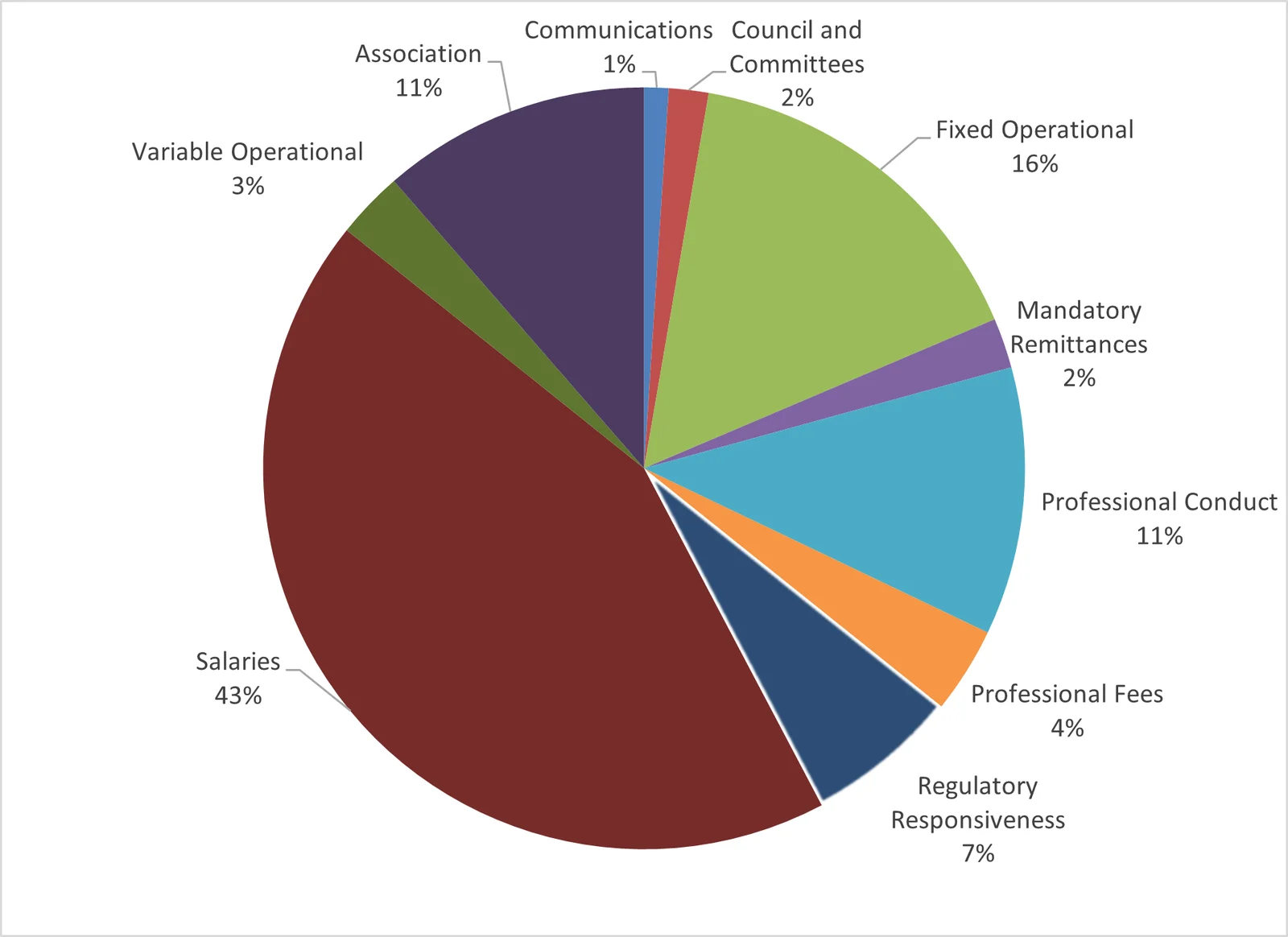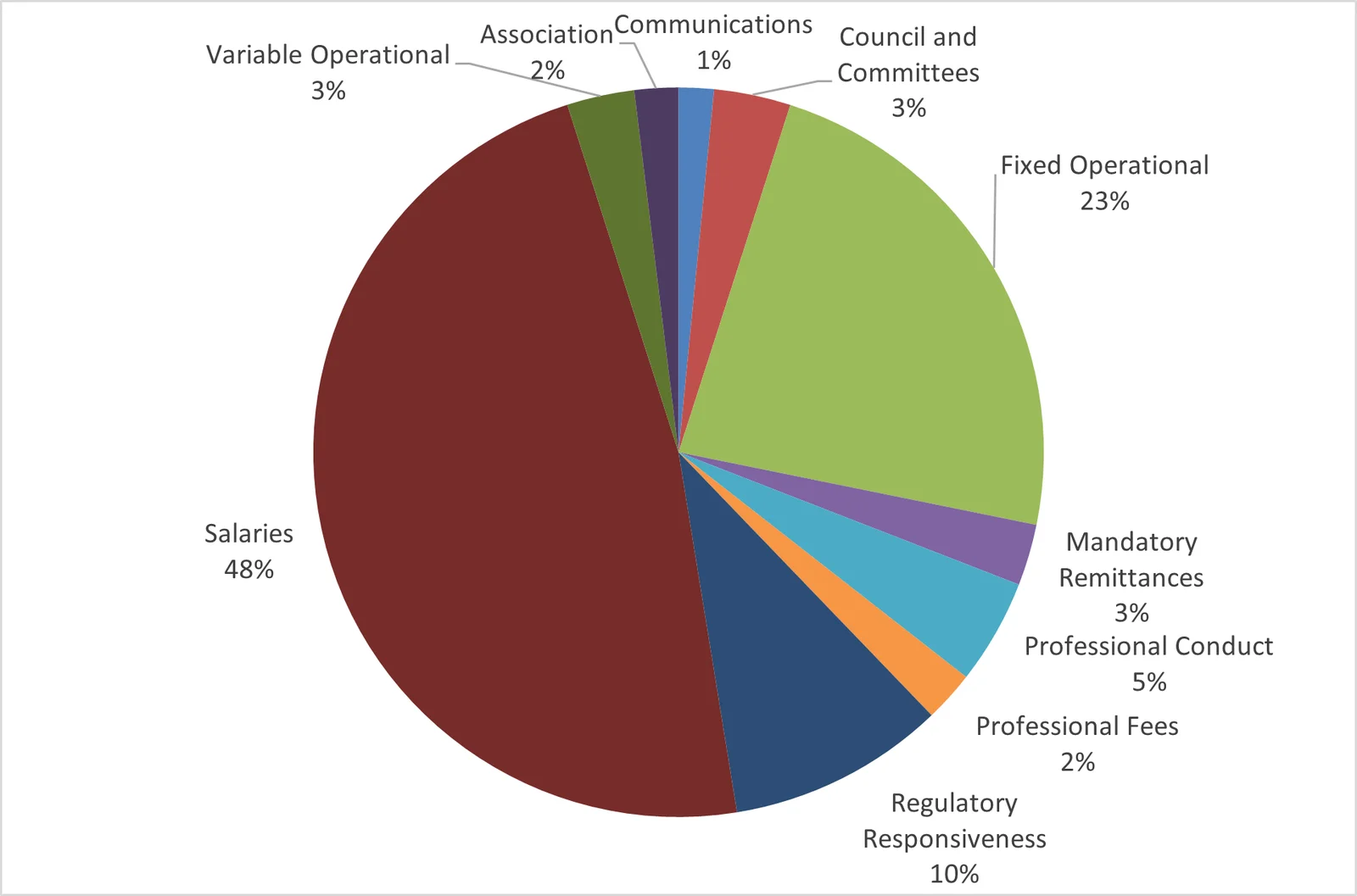Council has approved the 2022/2023 Fee Schedule. Council has made the decision that annual practice permit fees will remain unchanged this registration year. It is recognized that regulated members will have questions regarding this decision given the mandated separation of College and Association required by legislation and that the college has devolved itself of association functions. Council recognizes that some registrants may have anticipated a fee decrease.
What does the College do with money collected from fees?
The role of the College of Physiotherapists of Alberta is defined in the Health Professions Act (HPA). The College’s organizational structure and core functions flow from that mandated in the HPA. The Government of Alberta awards the right to regulate sparingly, and when they do, they require assurances through annual reporting including financial position that the college is not only functioning properly but has the resources to do so. The college is self-funded almost exclusively by regulated member fees. With Bill 46 amendments, the Government of Alberta requires any profession applying to be a regulated profession to submit a preliminary budget for management of the proposed college and the performance of the proposed colleges responsibilities under the Health Professions Act to provide assurance that all regulatory colleges will fulfill its mandated functions. The expectation with regulatory colleges and regulation is that the college is self-funded.
Each college needs to carry out the following:
- Registration: Register only qualified and competent physiotherapists involves setting the entry to practice requirements, reviewing applications, and managing the registration of registrants (initial registration, annual renewals, cancellations, authorizations, regulatory history forms)
- Continuing Competence Program: Establish and administer the continuing competence program that helps registrants maintain competence and enhance the provision of physiotherapy services.
- Complaints, Investigations and Discipline: The college must receive complaints and investigate them adequately. The College of Physiotherapists of Alberta processes all complaints in accordance with the HPA. Complaints that are referred to a hearing tribunal are conducted like a court proceeding, typically with lawyers representing all parties and the length of the hearing ranging from a single day to multiple days.
- Patient Relations Program: The college must establish a patient relations program which includes measures for preventing and addressing sexual abuse of and sexual misconduct towards patients by registrants. This includes a fund for treatment and counselling for patients who have experienced sexual abuse or sexual misconduct by a physiotherapist. A College is liable for $22,500 for each patient who has experienced sexual abuse or sexual misconduct by a physiotherapist.
- Policy and Practice: The college must set practice and professional standards (standards of practice, Code of Ethical Conduct) and support members understanding to their regulatory responsibilities (practice advice, resource development guides, podcasts, webinars)
What do fees pay for?
The college has a single source of revenue, and this is registrant dues, and any associated fees and penalties. Below is a table that provides details of what registrant fees pay for.
It may seem remarkable that 43% of registrant dues go towards staffing expenses, however regulation is human resource intensive. The college must have staff to carry out each statutory function on a day-to-day basis and make iterative changes to how we do business. These changes may be driven by legislation such as the Fair Registration Practices Act and amendments to the Health Professions Act or events such as the COVID-19 pandemic that resulted in cancellation of the Physiotherapy Competency Examination and the college having to respond to the unavailability of the licensure exam. The college is constantly updating policies and procedures and improving the work we do to respond to these changes. To fulfill our mandate and be an effective regulator, we require human resources.
Council and Committees |
2% |
Per diems, education |
Professional Conduct |
11% |
Investigations, expert opinions, legal fees, hearing tribunal expenses, patient relations program (funding and treatment) |
Communications |
1% |
Marketing, online store (discontinued January 1, 2022), branding |
Fixed Operational Costs |
16% |
Rent, insurance, telephone, security, printing, supplies, postage, bank charges, lease equipment, computer equipment, IT support, technology/programs |
Variable Operational Costs |
3% |
Membership levies/dues (Alberta Federation of Regulated Health Professions, Canadian Alliance of Physiotherapy Regulators), Donations, Sponsorships |
Professional Fees |
4% |
Legal (general), Auditor, contractors (HR) |
Salaries and Expenses |
43% |
Salaries for all positions, benefits (vacation, RRSP etc.), professional development |
Mandatory Remittances |
2% |
CPP, EI, WCB |
Regulatory Responsiveness |
7% |
Strategic planning, Projects for quality improvement, competence, registration, practice and policy |
Association |
11% |
Provided seed-funding and start-up costs in 2021/2022 fiscal year for the association |
How much money was spent on Association functions?
Since 2017, the College spent on average $200,000.00 per year on Association functions. A high of $285,162.00 and a low of $128,252.00.
The dollars spent included member awards, managing the online store from which physiotherapists could order Physiotherapy Alberta branded materials for their practices (developing materials, printing, postage), branding to promote the profession, marketing campaigns, sponsorships, Clinical Research Innovation Fund, Conferences, clinical professional development webinars, course postings, job board and clinical toolkit resources. Some association functions managed by the college were achieved with operational efficiencies as we could perform these functions at no cost because our systems would permit this such as the Find a PT section of the website.
On May 1, 2022, the College had 3416 regulated members meaning that approximately $58.00 of each registrant’s annual practice permit fee in past years funded “association functions”.
Then why aren’t my fees going down by $58?
Council decided that fees would not be lowered at this time to ensure the college is able to respond to the demands required of a regulatory college.
The College is facing ongoing uncertainty related to several of our core functions:
- Professional Conduct: Not only is the College is seeing an increase in complaints, but the complexity of complaints and associated costs are increasing. One factor is the change related to the 2019 "Bill 21 "An Act to Protect Patients" having mandatory penalties and requiring the College set aside funds for treatment and counselling for patients who have experienced sexual abuse or sexual misconduct by physiotherapists while a patient. This fiscal year, the College has three sexual abuse/sexual misconduct complaint hearings. These complaints often have greater associated investigation and legal costs due to the serious nature of the complaint. No patient should ever endure sexual abuse and sexual misconduct; therefore, resources are available for these patients. On December 31, 2021 the College was responsible for $92,500 to cover treatment and counseling services. The cost of these resources will increase as patients may access this funding for up to five years following the investigation.
- Changing Legislation: Responding to the changes mandated by Bill 46, such as the work to divest ourselves of Association functions and related rebranding, has come with significant costs for the College, and the work of implementing Bill 46 is not yet complete. Other recent legislative changes such as Bill 49 the Labor Mobility Act will similarly result in operational costs.
- Responding to pandemic related challenges: The College has engaged in work to review registration practices and to offer a clinical examination during the ongoing exam disruptions resulting from the pandemic. This comes with costs. The College is currently awaiting the recommendations of the psychometric review of the clinical exam and the registration practices review. The recommendations and work stemming from these reviews, and associated costs, is currently unknown.
In addition to this uncertainty, it bears noting that the College’s fixed operational costs remain unchanged and we are currently in the highest inflationary period we have seen in many years.
Why have my fees increased over time?
Over the last twenty years, the fees paid by regulated members have been affected by two main factors:
- Increasing regulatory costs, including complexity of complaints and related conduct costs
- Inflation
Between 1994 and 2004, fees were stable at $325. In 2005, 2007 and 2009 a series of fee increases were instituted to bring fees in line with increasing regulatory costs, including:
- Increased operating costs related to the increasing number of regulated physiotherapists,
- Increased number of complaints as the College increased in size
- The risks of serious complaints as increasing numbers of physiotherapists engaged in restricted activities
- The need to set aside reserve funds to cover unexpected conduct costs incurred outside the normal budgeted amount
In 2010, when the college assumed some association functions, annual practice permit fees were $550, the same as they had been the prior year.
In 2011 the College came under the Health Profession Act and Physical Therapists Profession Regulation. The fees in 2011 were $646. The increased fees in 2011 were associated with increased regulatory costs related to the transition to the new governing legislation. This was also the year that individual professional liability insurance became mandatory (it was only recommended prior to coming under the HPA). Some regulated members may associate the cost related to the purchase of mandatory liability insurance with the assumption of association functions.
Council has always stated that fees may be adjusted annually by an inflation factor, and that Council will make this decision each year. Using an inflation calculator, the 2011 fees would be equivalent to $813.66 in 2022. Practice permit renewal fees are currently $805.
There were many years the fees were not increased by the inflation factor. The last fee increase was in 2019.
Why are my practice permit fees more than my colleague who is also a regulated health professional?
Each health regulatory college does carry out the same statutory functions; however, the relative weight of the various functions somewhat depends on the profession itself. Let’s use complaints and investigations as an example.
Simply being a larger profession translates into an increased number of complaints. In Alberta regulatory college size ranges from approximately 200 registrants up to 35,000 registrants. The College of Physiotherapists of Alberta has approximately 3,400 registrants.
The nature of the profession also affects the type and complexity of complaints. Physiotherapy is a touching profession which can result in more complex complaints including sexual abuse and sexual misconduct complaints than as compared to other “low touch” professions, such as opticians.
The size of the membership alone is not enough to judge whether fees should be more or less, the nature of the profession and the work of the college itself must be considered.
How do current college expenses compare to 2009 when the college was a single mandate organization? (The college assumed association functions in 2010)
It is interesting to compare expenses from 2009/2010 with current day. As you can see, salaries and fixed operational expenses have decreased in current day; however, professional conduct expenses has more than doubled compared to 2009/2010. The Association expenses in 2021/2022 were higher than that in 2009/2010 as current Council committed to providing seed funding and start up support for the new association that was being formed in Alberta this fiscal year. Many of the other expenses have remained consistent.
2021/2022

2009/2010





